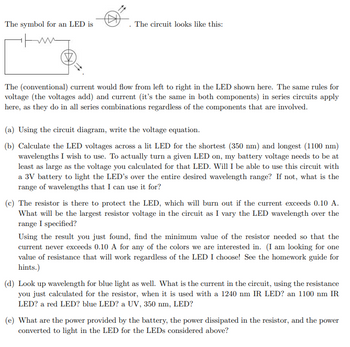
Concept explainers
An LED is very efficient because within the LED itself, the electrical energy is directly converted
to light. This energy transfer happens one electron at a time: each electron that crosses the LED
loses the same amount of energy by emitting a a photon whose energy (in eV) is hc/λ, where
hc = 1240eV nm and λ is the wavelength of the light, in nm. The change in the electron’s electrical
energy is, of course, U = eV where e is the electron charge and V the voltage across the LED. When
the LED is on it will therefore have a constant voltage in Volts VLED = hc/(eλ) = 1240/λ across it,
where λ is the wavelength in nanometers. If no current flows, i.e. if the voltage would be less than
VLED, the LED is off and acts like an open switch and has whatever lower voltage is consistent with
the rest of the circuit.
Consider a circuit with an ideal 3V battery, a resistor and an LED in series. We’d like to use the
circuit to light LED’s ranging in color from the infrared (wavelength of 1100 nm) to the near UV
(about 350 nm.)


Trending nowThis is a popular solution!
Step by stepSolved in 2 steps with 2 images

- Explain why silicon solar cells mainly use SiN with a thickness of 70 nm as ananti-reflection filmarrow_forwardAt a temperature of 27 Celsius in silicon, the intrinsic carrier concentration is 1.5 x 1010 /cm³. What is the intrinsic carrier concentration if the temperature is increased to 48 Celsius?arrow_forwardCalculate the equivalent resistances Rin of the following circuits. (The resistance value of the diodes in the conduction will be 0, the resistance value of the diodes in the insulation will be taken as infinity. R1=10ohmarrow_forward
 Introductory Circuit Analysis (13th Edition)Electrical EngineeringISBN:9780133923605Author:Robert L. BoylestadPublisher:PEARSON
Introductory Circuit Analysis (13th Edition)Electrical EngineeringISBN:9780133923605Author:Robert L. BoylestadPublisher:PEARSON Delmar's Standard Textbook Of ElectricityElectrical EngineeringISBN:9781337900348Author:Stephen L. HermanPublisher:Cengage Learning
Delmar's Standard Textbook Of ElectricityElectrical EngineeringISBN:9781337900348Author:Stephen L. HermanPublisher:Cengage Learning Programmable Logic ControllersElectrical EngineeringISBN:9780073373843Author:Frank D. PetruzellaPublisher:McGraw-Hill Education
Programmable Logic ControllersElectrical EngineeringISBN:9780073373843Author:Frank D. PetruzellaPublisher:McGraw-Hill Education Fundamentals of Electric CircuitsElectrical EngineeringISBN:9780078028229Author:Charles K Alexander, Matthew SadikuPublisher:McGraw-Hill Education
Fundamentals of Electric CircuitsElectrical EngineeringISBN:9780078028229Author:Charles K Alexander, Matthew SadikuPublisher:McGraw-Hill Education Electric Circuits. (11th Edition)Electrical EngineeringISBN:9780134746968Author:James W. Nilsson, Susan RiedelPublisher:PEARSON
Electric Circuits. (11th Edition)Electrical EngineeringISBN:9780134746968Author:James W. Nilsson, Susan RiedelPublisher:PEARSON Engineering ElectromagneticsElectrical EngineeringISBN:9780078028151Author:Hayt, William H. (william Hart), Jr, BUCK, John A.Publisher:Mcgraw-hill Education,
Engineering ElectromagneticsElectrical EngineeringISBN:9780078028151Author:Hayt, William H. (william Hart), Jr, BUCK, John A.Publisher:Mcgraw-hill Education,





